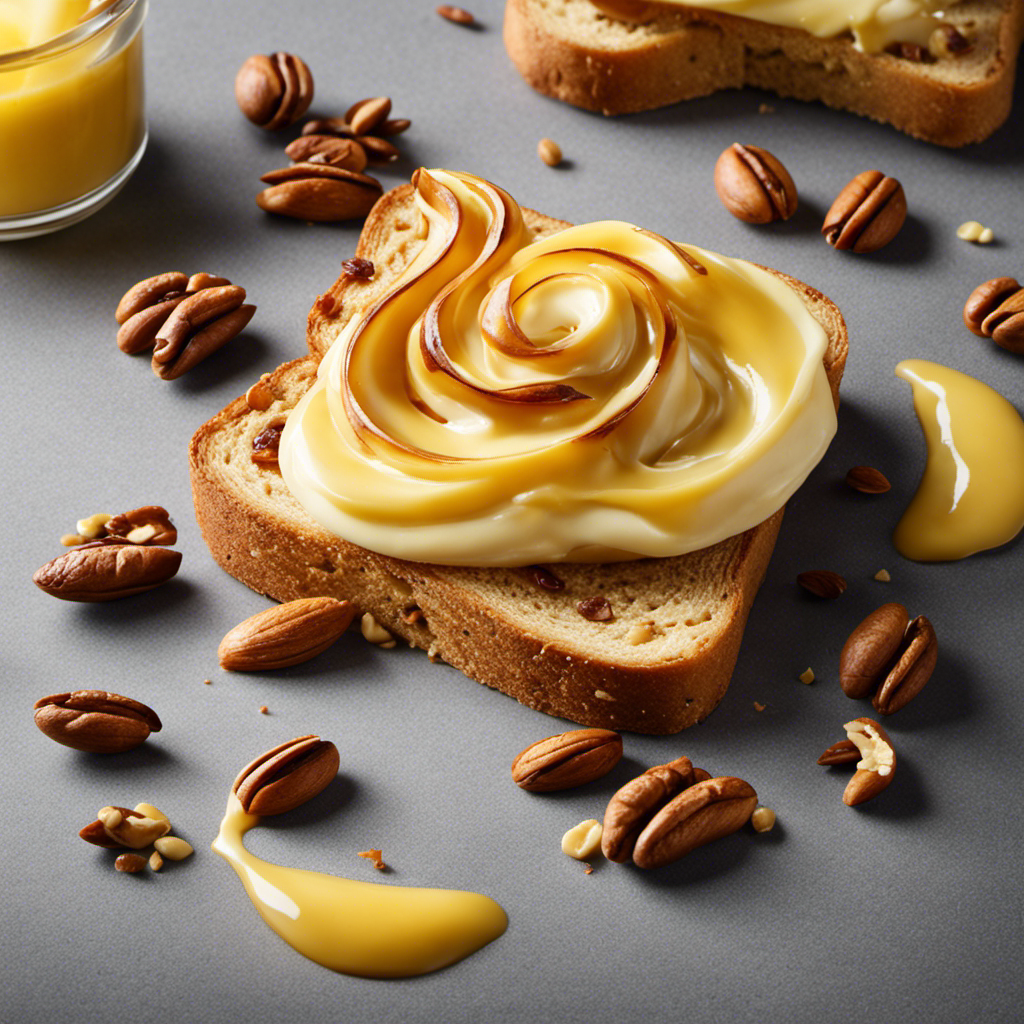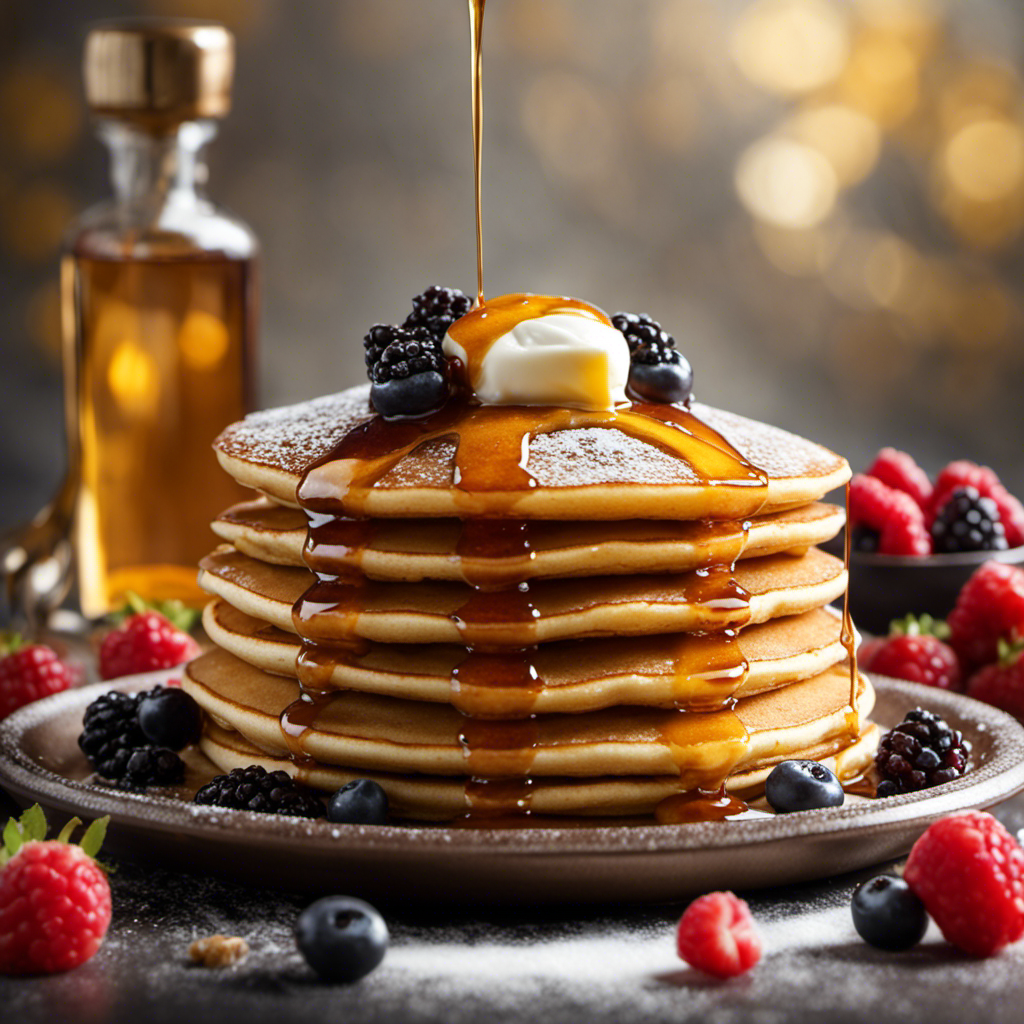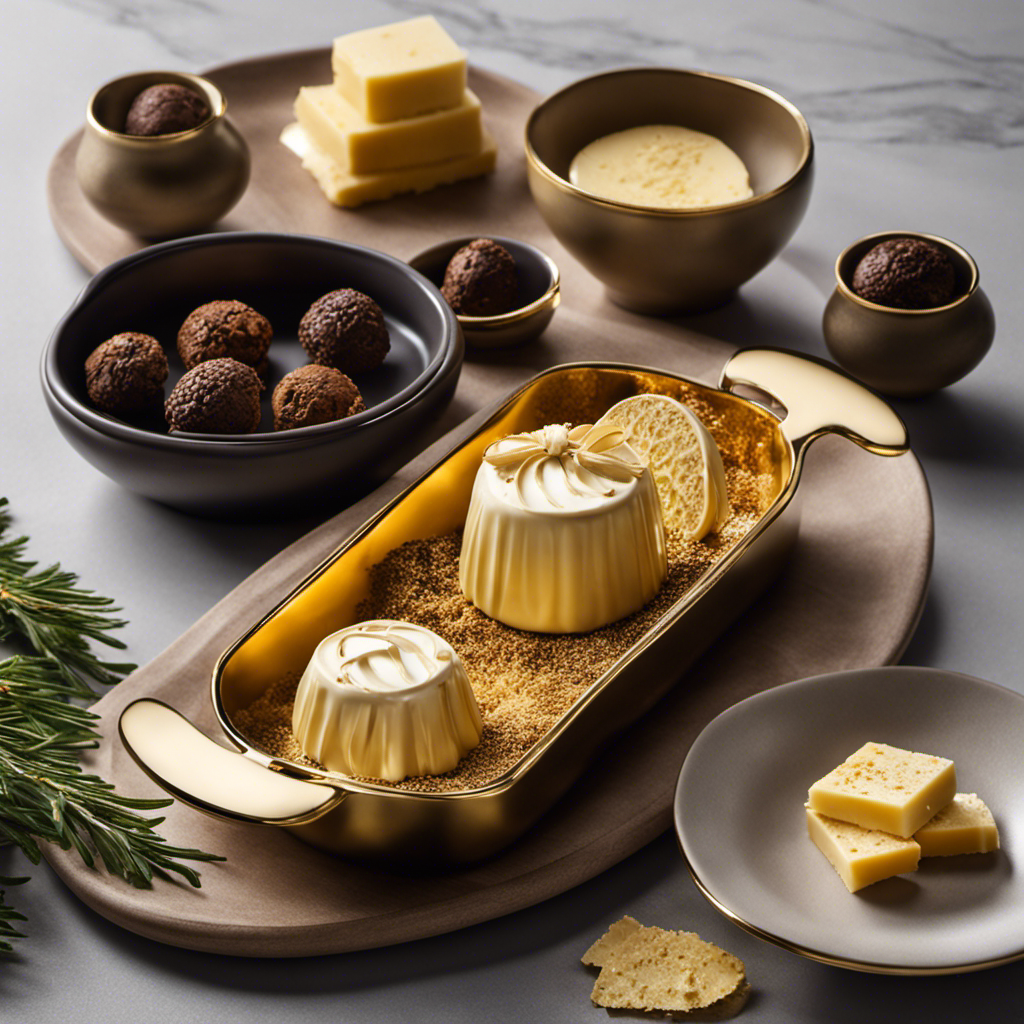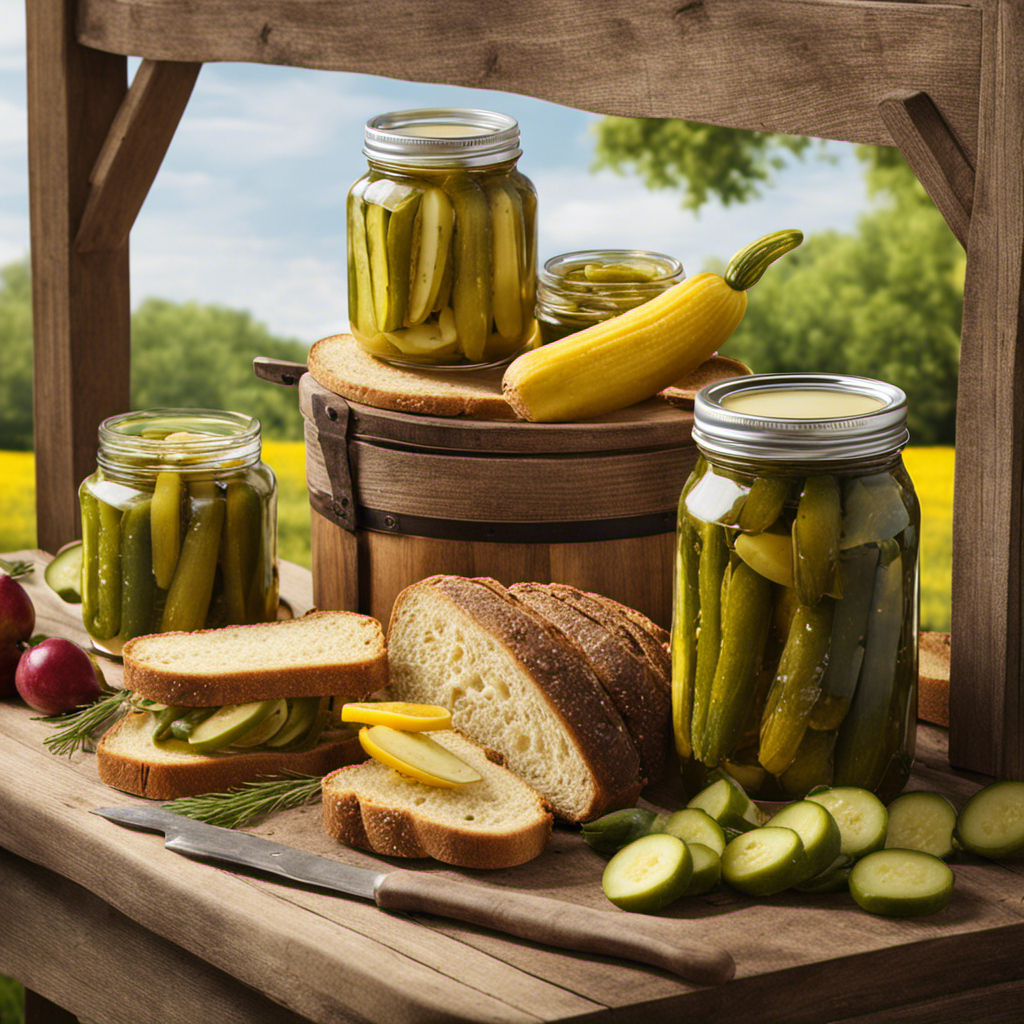As a lover of all things rich and buttery, I never thought I would support an alternative. However, I have to admit that ‘not butter’ has completely surprised me with its appeal.
In this article, we’ll dive into the origins of this alternative spread, explore its health benefits, and even learn how to make it at home.
So if you’re curious about what ‘not butter’ has to offer, stick around and prepare to be pleasantly surprised.
Key Takeaways
- ‘Not Butter’ originated in the 1980s as a healthier alternative to butter, aiming to replicate its taste and texture.
- Traditional butter is high in saturated fat and cholesterol, which can contribute to heart health issues.
- Margarine is often chosen over butter for its lower saturated fat content, and there are many alternative spreads available for healthier options.
- Alternative ingredients for ‘Not Butter’ include avocado, nut butters, and vegan butter substitutes made from plant-based oils, which are lower in saturated fats and cholesterol.
The Origins of "Not Butter
The origins of ‘not butter’ can be traced back to the 1980s. During that time, there was a growing demand for healthier alternatives to traditional butter due to increased awareness of the negative effects of saturated fats on health.
As a result, the evolution of ‘not butter’ recipes began, aiming to replicate the taste and texture of butter while offering a healthier option. These recipes often incorporated ingredients such as vegetable oils, margarine, and other plant-based fats.
‘Not butter’ alternatives gained cultural significance as they provided dietary options for individuals with lactose intolerance, vegan diets, or those seeking to reduce their saturated fat intake.
Today, ‘not butter’ products continue to evolve, catering to a wide range of dietary preferences and health concerns.
The Health Concerns of Traditional Butter
When it comes to the health concerns of traditional butter, there are three key points that are often discussed: its saturated fat content, its impact on cholesterol levels, and the availability of alternatives and substitutes.
Traditional butter is high in saturated fat, which has been linked to an increased risk of heart disease. Additionally, it contains cholesterol, which can further contribute to heart health issues.
However, there are various alternatives and substitutes available that can provide a healthier option for those looking to reduce their intake of saturated fat and cholesterol.
Saturated Fat Content
One of the main reasons people choose margarine instead of butter is because it has a lower saturated fat content. Many individuals are looking for low-fat options to maintain a healthy lifestyle and reduce the risk of health issues such as high cholesterol levels. To better understand the impact of saturated fat content, let’s take a look at the following table:
| Butter | Margarine | |
|---|---|---|
| Saturated Fat (g) | 7.2 | 1.9 |
| Trans Fat (g) | 0.3 | 0.1 |
| Cholesterol (mg) | 31 | 0 |
| Calories (per serving) | 102 | 100 |
| Source | Animal | Plant |
As shown in the table, margarine has significantly lower saturated fat content compared to butter. This makes it a popular choice for those who are concerned about their cholesterol levels. However, it is important to note that the type of fat consumed, whether saturated or unsaturated, can also impact cholesterol and heart disease. Transitioning to the next section, we will explore the relationship between cholesterol and heart disease.
Cholesterol and Heart Disease
Transitioning to cholesterol and heart disease, it’s important to understand how saturated fat consumption can impact these health conditions.
Research has shown a clear link between the intake of saturated fats and an increase in cholesterol levels, particularly LDL (low-density lipoprotein) cholesterol. This type of cholesterol is often referred to as ‘bad’ cholesterol because it can build up in the arteries and increase the risk of heart disease.
Butter, being high in saturated fat, can contribute to elevated cholesterol levels and therefore increase the risk of heart disease.
To summarize, the link between butter and heart health can be attributed to its saturated fat content and its potential to raise cholesterol levels. This understanding paves the way for exploring alternatives and substitutes that can be used in place of butter.
Alternatives and Substitutes
To reduce your intake of saturated fats and lower your risk of heart disease, you can explore alternatives and substitutes for butter.
There are numerous alternative spreads available that can provide a healthier option for spreading on toast or using in recipes. One popular choice is avocado, which is not only delicious but also packed with heart-healthy monounsaturated fats.
Another option is nut butter, such as almond or cashew butter, which can provide a creamy texture and a dose of healthy fats.
For those following a vegan diet, there are also vegan butter substitutes made from plant-based oils like coconut or olive oil. These alternatives can be just as tasty and versatile as butter, while also being lower in saturated fats and cholesterol.
Alternative Ingredients for "Not Butter
Using alternative ingredients can be a great way to make ‘not butter’ suitable for different dietary needs. There are several benefits of using alternative ingredients in ‘not butter’:
-
Coconut oil: Coconut oil is a popular choice as an alternative ingredient in ‘not butter’ due to its creamy texture and mild flavor. It is also rich in healthy fats and can provide a good source of energy.
-
Avocado: Avocado can be used as a substitute for butter in certain recipes. It adds a creamy texture and a subtle flavor to dishes. Avocado is also packed with nutrients like healthy fats, vitamins, and minerals.
-
Nut butters: Nut butters such as almond butter or cashew butter can be used in place of butter in some recipes. They provide a rich and nutty flavor while also adding a dose of healthy fats and protein.
How to Make "Not Butter" at Home
After exploring alternative ingredients for ‘not butter,’ let’s move on to the exciting process of making it at home. When it comes to replicating the taste and texture of ‘not butter,’ there are a few key factors to consider. First, the taste should resemble that of traditional butter, but without the dairy. Second, the texture should be creamy and spreadable, just like real butter. To achieve these qualities, a combination of plant-based oils, such as coconut oil, and non-dairy milk can be used. By blending these ingredients together and adding a pinch of salt for flavor, you can create a delicious and satisfying ‘not butter’ spread at home. Experimenting with different ratios of oils and milk can help you fine-tune the taste and texture to your liking. So go ahead and give it a try – you might just discover a new favorite spread!
| Ingredient | Purpose | Amount |
|---|---|---|
| Plant-based oil (e.g., coconut oil) | Provides a creamy texture | 1 cup |
| Non-dairy milk (e.g., almond milk) | Adds moisture and enhances flavor | 1/4 cup |
| Salt | Enhances the taste | Pinch |
The Benefits of Using "Not Butter
Looking for a healthier alternative to butter? ‘Not Butter’ is a great option.
It is suitable for dietary restrictions such as lactose intolerance and vegan diets.
Plus, it is versatile in cooking, making it a convenient choice for a variety of recipes.
Healthier Alternative to Butter
If you’re watching your cholesterol, try a healthier alternative to butter. ‘Not butter’ is a great option that provides the taste of butter without the negative effects on your health.
Here are some nutritional benefits of ‘not butter’:
-
Cholesterol-free: Unlike butter, ‘not butter’ is made from plant-based oils, which means it contains zero cholesterol. This is especially important for individuals with high cholesterol levels.
-
Lower in saturated fat: ‘Not butter’ is typically lower in saturated fat compared to butter. High intake of saturated fat has been linked to an increased risk of heart disease, so opting for ‘not butter’ can be a heart-healthy choice.
-
Fortified with vitamins: Many ‘not butter’ products are fortified with vitamins such as vitamin A, D, and E. These vitamins play essential roles in maintaining good health and supporting various bodily functions.
Suitable for Dietary Restrictions
A suitable option for those with dietary restrictions is a butter alternative that caters to various needs. There are many individuals who follow a vegan lifestyle or have food allergies and are unable to consume traditional butter. Fortunately, there are several options available in the market that are suitable for vegans and offer allergen-friendly alternatives. These butter alternatives are made from plant-based ingredients and are free from common allergens such as dairy, nuts, and soy. They provide a similar texture and taste to butter, making them a great substitute in cooking and baking. Here is a table showcasing some popular butter alternatives that are suitable for vegans and offer allergen-friendly options:
| Butter Alternative | Vegan Friendly | Allergen Friendly |
|---|---|---|
| Vegan Butter | Yes | Yes |
| Coconut Oil | Yes | Yes |
| Olive Oil | Yes | Yes |
| Avocado Spread | Yes | Yes |
These butter alternatives are not only suitable for those with dietary restrictions, but they are also versatile in cooking.
Versatile in Cooking
You can use these versatile butter alternatives in a variety of cooking methods, such as sautéing, baking, or spreading on toast. They offer a range of options for creating delicious and healthy recipes.
Here are some key benefits of these butter alternatives:
-
Heart-healthy: These alternatives are often made from plant-based oils that are rich in unsaturated fats, which can help lower cholesterol levels.
-
Vegan-friendly: Many butter alternatives are free of animal products, making them suitable for those following a vegan or plant-based diet.
-
Allergy-friendly: Some alternatives are made from nuts or seeds, providing a great option for those with dairy or soy allergies.
These versatile butter alternatives not only provide a creamy and flavorful addition to your dishes, but they also offer nutritional benefits that can support a healthy lifestyle.
Cooking and Baking Tips With "Not Butter
When cooking and baking with ‘not butter’, it’s important to consider the temperature at which it should be melted. ‘Not butter’, a popular alternative to traditional butter, is made from plant-based oils and has a lower melting point.
To ensure successful baking, it is recommended to melt ‘not butter’ at a lower temperature than regular butter. This will prevent any potential burning or altering the texture of the baked goods.
When incorporating ‘not butter’ into savory dishes, it is crucial to note its different composition compared to traditional butter. ‘Not butter’ may have a slightly different taste and texture, so it’s important to adjust the other ingredients and seasonings accordingly.
Experimenting with different ratios and flavors can help achieve the desired results when cooking with ‘not butter’.
Exploring Different Varieties of "Not Butter
In my previous subtopic, I discussed some cooking and baking tips with ‘Not Butter’. Now, let’s explore the world of ‘Not Butter’ and the different brands available.
When it comes to spreads that mimic the taste of real butter, there are several options to choose from. Here are some key brands to consider:
-
Brand A: Known for its rich and creamy flavor, Brand A offers a smooth texture that melts perfectly on toast or muffins.
-
Brand B: With a slightly tangy taste, Brand B provides a unique twist on the classic butter flavor. It’s great for adding a hint of zing to your favorite dishes.
-
Brand C: If you prefer a lighter alternative, Brand C offers a delicate and airy texture. It’s perfect for those looking for a subtle buttery taste.
When comparing these brands, it’s important to consider personal preference and the intended use of the spread. Experimenting with different varieties will help you find the perfect ‘Not Butter’ that suits your taste buds.
Frequently Asked Questions
Is ‘Not Butter’ a Suitable Substitute for Traditional Butter in Baking Recipes?
Yes, "not butter" can be a suitable substitute for traditional butter in baking recipes. It helps overcome baking challenges with dairy-free substitutes and is a great option to explore for vegan baking.
Does ‘Not Butter’ Contain Any Dairy or Animal Products?
‘Not butter’ is a vegan friendly alternative to traditional butter. Its main ingredients are plant-based oils and emulsifiers. It does not contain any dairy or animal products, making it suitable for those following a vegan lifestyle.
Can ‘Not Butter’ Be Used for Spreading on Toast or Bread?
Yes, ‘not butter’ can be used as a spread on toast or bread. It offers nutritional benefits like being low in saturated fats. Additionally, it can be used in creative recipes as a vegan alternative to butter.
Are There Any Specific Health Concerns Associated With Consuming ‘Not Butter’?
There may be specific health concerns associated with consuming "not butter," such as its effects on cholesterol and potential allergic reactions. It is important to consider these factors before incorporating it into your diet.
How Does the Taste of ‘Not Butter’ Compare to Traditional Butter?
When comparing the taste of ‘not butter’ to traditional butter, it’s important to consider the texture as well. Although ‘not butter’ may have a similar flavor, its texture might differ due to variations in ingredients and processing methods.
Conclusion
In conclusion, ‘Not Butter’ is a revolutionary alternative to traditional butter that offers numerous health benefits without compromising on taste. By using alternative ingredients and homemade techniques, you can easily make your own ‘Not Butter’ at home.
The versatility of ‘Not Butter’ makes it perfect for cooking and baking, allowing you to explore a whole new world of flavors and possibilities. With its various varieties to choose from, ‘Not Butter’ is the answer to all your culinary needs.
So why wait? Try ‘Not Butter’ today and embark on a delicious and healthy journey.









